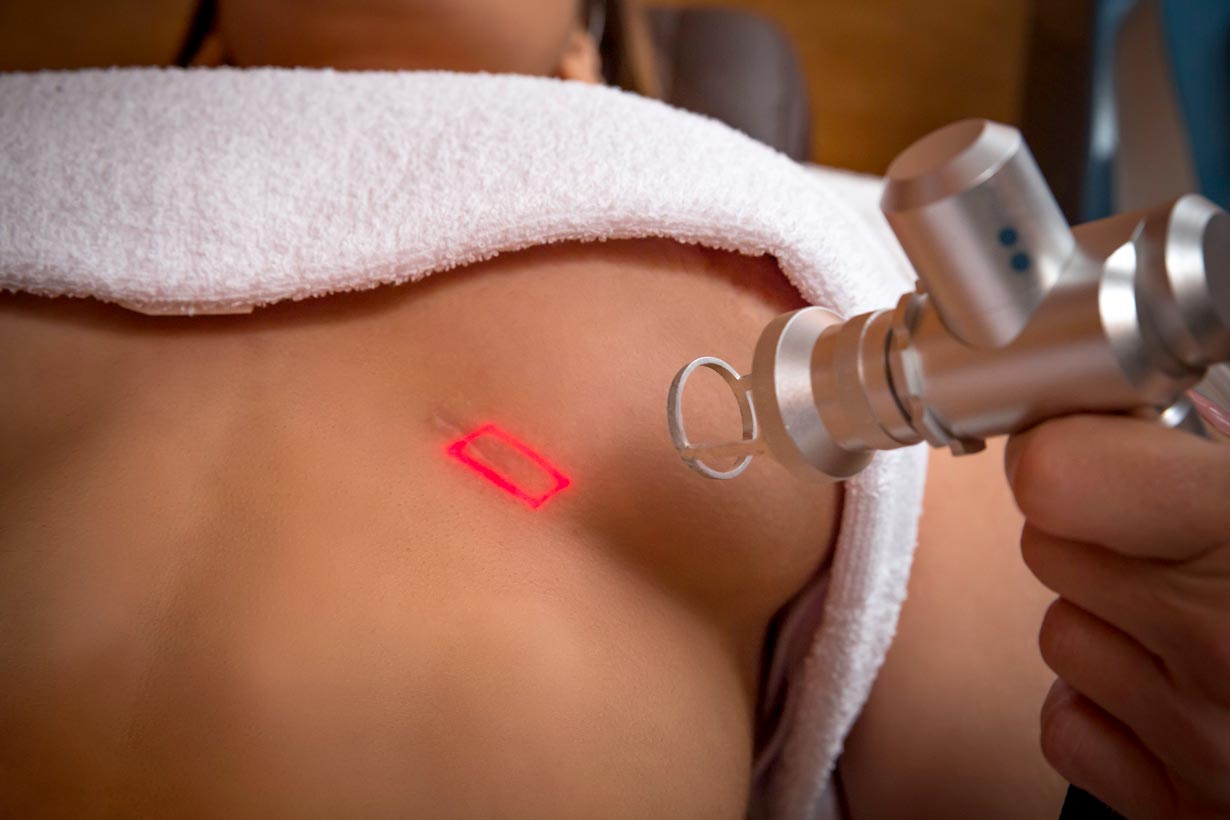Laser Therapy Can Help Remove Keloid Scars

Laser technology is complex, but in basic terms an electric current is passed through a substance called a laser medium (e.g., carbon dioxide), stimulating the molecules to emit particles of light that bump into and amplify each other. Mirrors are used to control the light particles into a stream and direct it. The medium determines the wavelength of the light, and specific molecules and areas in the skin absorb different wavelengths.28
There are several different types of lasers that have both been used for treatment of keloids. A good way to understand the types of treatments available is to first know if the treatment is considered ablative or non-ablative. Ablative treatments, such as carbon dioxide (CO2) lasers, are essentially used like surgical scalpels that cut out (or vaporize) and cauterize scar tissue—but are generally less traumatic than actual surgery.27,29 Non-ablative lasers are basically non-invasive heating mechanisms. The 585-nm pulsed-dye laser therapy (PDL) is generally the recommended non-ablative treatment.3,26
So which one is right for you? Your doctor will look at different factors to determine which laser treatment is best for you. These factors will also help determine the specifics of your treatment program, including how many sessions you may need:26
- Skin phototype (level of skin pigment, or how light or dark your skin is)
- Scar specifics (type, color, texture, and area of the body)
- Prior treatment
- Current and past medications
- Infection or inflammation
Certain medications or prior therapies may delay or preclude laser therapy. For example, those who have taken or are currently taking isotretinoin (e.g., Accutane®) will typically be advised to wait for at least six months because of increased risks of adverse side effects. Those taking blood thinners should discontinue use for a week (or more, depending on doctor’s advice).26
If a patient has had injections of cosmetic fillers or hypopigmentation from previous treatments, laser therapy may not be advisable or even possible. Finally, the
| LASER THERAPY DETAILS | |
|---|---|
| What Happens During Treatment |
For both treatment options, the scar site and surrounding skin will be cleaned with soap and water since deodorants, cosmetics, or creams can interfere with the laser.26 Non-Ablative Treatment Options 585-nm PDL and Nd:YAG (1064-1320 nm) Laser Therapy26,29
Ablative Treatment Options CO2 and ER:YAG Laser Therapy26
|
| Other Things to Expect Before and After Treatment | Before: Usually done without any anesthesia, but a topical numbing cream can be applied 30 minutes to an hour before therapy session if desired.26 All people in the treatment room, including the patient, must wear protective glasses to avoid eye damage.26 Wet gauze might be used to protect areas of the skin with hair during treatment.26 After: Wash the treated areas daily with mild soap and water and avoid allowing direct sunlight to reduce the risk of hyperpigmentation. If this occurs treatments may have to be delayed until it goes away on its own or with a little help from a topical bleaching agent.26 For ablative laser treatments, typically the skin around the treated scar site will temporarily become darker at about 3-6 weeks. The skin will dry and flake around the wound site right after treatment but usually resolves within a month.27 Following treatment, PDL patients may experience temporary bruising that may last about a week and swelling that should go away in about two days.26 |
How Often | 6-8 weeks between PDL treatments as needed; keloids generally require more sessions than hypertrophic scars.26 |
| Types Used |
|
| Typical Dosage | 585-nm PDL26
|
Is it Painful? | None reported (other than surgical pain).17,27 |
| Side Effects | With PDL, temporary bruising may occur. Other adverse side effects include hyperpigmentation and sores.17 |
How Do Lasers Work?
In laser therapy, continuous waves or pulses of energy are directed at the scar tissue. The type of laser and how it is used determines how it affects the keloid scar.28
Carbon dioxide and argon lasers work by shrinking collagen with excessive heat, and can be used as a surgical means to both cut out a keloid and cauterize the wound site.3,28
585-nm PDL, a non-ablative laser, creates heat in the vascular cells within the keloid, cutting off the blood supply. Some studies indicate PDL also inhibits inflammatory factors while promoting enzymes that break down collagen.21
Evidence of Benefit
Although some researchers report that carbon dioxide lasers are ineffective for keloid treatment,2 others report some success.3 Argon lasers actually had worse recurrence rates than carbon dioxide laser by itself%.3 With recurrence rates of over 90% in some cases for both carbon dioxide and argon, experts do not recommend them to be used by themselves as a monotherapy.21 Carbon dioxide lasers do appear to work better when used in conjunction with other therapies (e.g., interferon and with steroid injections).3
Laser therapy is not as effective and more risky in patients with darker skin (whether from tanning, race, or ethnicity). This is because the increased melanin pigment absorbs energy in the same wavelength range as hemoglobin in red blood cells. Since the melanin is located in the uppermost layer it absorbs the laser energy and keeps it from all reaching the blood vessels inside the keloid, which interferes with resolution of the keloid itself. At the same time, by absorbing all this energy the melanin-producing skin cells are destroyed by the laser, and can result in hypopigmentation.26
Experts recommend using lower density dosage levels for naturally dark skin and waiting until tanned skin returns to normal before initiating laser treatments in order to improve results and reduce the chances of hypopigmentation.26,28
Pulsed dye lasers have been shown to significantly alleviate redness and itching of keloids, but their overall usefulness in resolving keloids by themselves is limited and study results on reduction in size are mixed.517 Used in conjunction with injections of steroids or 5-fluorouracil has reportedly better results.26
skin infections and inflammatory diseases may be worsened with laser treatment.

